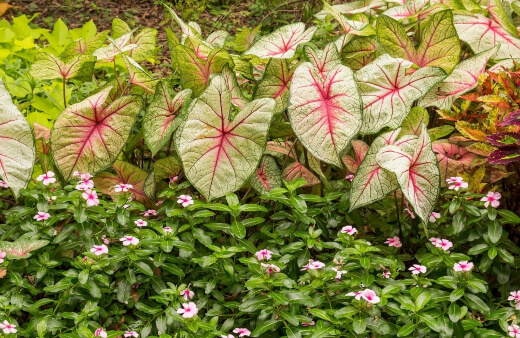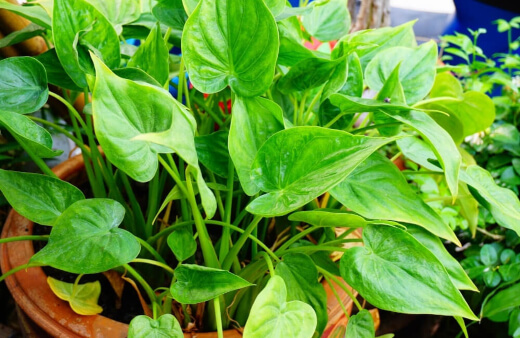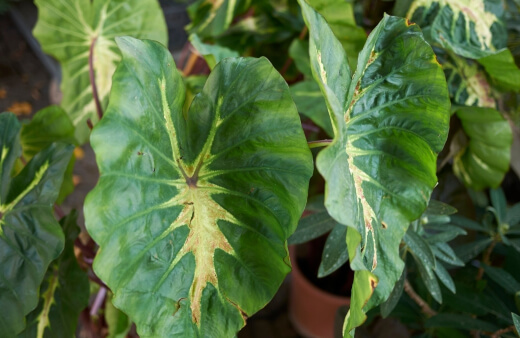If you're looking to add a taste of the tropics to your garden, then consider growing Elephant's Ear plants. These luscious perennials offer a bold texture and intricate leaves, making them perfect for around patios, ponds, edging, or ground cover.
Whether indoors or outdoors, here is everything you need to cultivate, care for and grow Elephant ear plants.
More...
Choosing Your Elephant's Ear Plant Cultivar

There are a variety of Elephant's ear cultivars available at most local nurseries, each with its unique appeal. This is why they have become such popular home and garden plants.
Depending on which cultivar you choose, Elephant's ear can be used as:
- A Perennial, border or focal plant.
- A dramatic centrepiece alongside flowering annuals.
- Part of a summer jungle garden with other tropical plants like banana trees.
Some of the most common Elephant's ear types include:
Caladium
Also known as 'angel wings', Caladiums are a small growing plant ideal for indoors. This South American Native prefers partial sun and shade throughout the day and moist, acidic soil.
These plants' biggest appeal is their uniquely patterned leaves that range in colour from green, white, red and pink. Learn more about Caladiums and its most popular varieties to grow here in Australia.

Colocasia
Native to Asia and India, this Elephant's ear type likes it warm and humid. It has a big, bold colour, making it great as a feature plant within your home, greenhouse, or patio.
Colocasia does require quite a bit of sunlight, however, it will adapt in partial shade. With this type, it's essential to keep the soil moist and full of rich, organic materials.
Check out our complete guide to growing Colocasia esculenta commonly known as Taro to find out more about this sought after root vegetable.
Alocasia
Alocasia is incredibly adaptable when it comes to lower light conditions. So, it will happily grow indoors. Also known as the 'African Mask Plant', this has unique upward-pointing leaves.
Native to subtropical Asia and Australia, alocasias require moist yet well-draining soil for optimal growth.
For more on this amazing type, check out our Alocasia – Australian Growing and Care Guide
Xanthosoma
These plants are likely the least featured in gardens but still offer fantastic foliage. Happy to grow in part shade, natives to the American tropics like it warm and moist. It, too, requires well-draining, rich soil.


Get Your Free Guide:
Master Growing Australian Natives eBook
A Must Have Complete Guide for Every Australian Garden
Get Your Free Guide:
Master Growing Australian Natives eBook
A Must Have Complete Guide for Every Australian Garden
How to Grow Elephant's Ear Plants

Elephant's ears are pretty easy to grow as long as you provide them with rich soil and the right amount of sun.
If you're planning on growing indoors, be sure to choose a larger container for your plant to grow into. If planting outdoors, only do so approximately 8 weeks post the last frost.
Cultivating Elephant's Ear
The most common method of cultivation is by means of division. Simply divide the tuber into pieces with a sterilized blade, each with a corn on it. Leave the pieces to dry out for a few days and then plant into soil, blunt end down, to root.
You can consider dipping the end into a rooting hormone. However, these plants tend to re-grow from their tubers pretty quickly.
Planting Elephant's Ear
Before planting, ensure the right temperature and conditions. If it's too cold, your plant may not survive.
When planting, you'll want to:
- Prepare the bed, turning the soil to at least 20 cm deep.
- Use a rake to remove any stones or debris from the soil.
- Compost the soil with rich organic matter.
- Plant your Elephant's ears at least 60 to 120 cm apart.
Once planted, be sure to water semi-regularly until established.
Elephant's Ear Plant Care

These plants require very basic care, provided they receive enough sunlight. It is recommended to water these plants in the mornings, so the soil can dry out before the cool of the night.
You'll want to try to keep water off of the leaves, so watering at the base of the plant is preferable. When it comes to fertiliser, Elephant's ear plants are not heavy feeders and will require very little fertilisation.
If you do fertilise, be sure to use a slow-release, water-soluble fertiliser or supplement your water with a little bit of Epsom salts.
These plants thrive in warmer climates and tropical regions. It is possible to grow Elephant's ears in colder climates. However, you will need to replant them each year to protect them from any frost.
To replant:
- Cut back a large portion of foliage.
- Dig up the rhizomes leaves overnight to dry out.
- Fill a container with coconut coir and leave your plants in a warm, slightly sunny spot.
Alternatively, keep your plants in a pot or container even in the garden, so they can be moved when the winter chill sets in. If growing indoors, fertilise your Elephant ear plant only in the summertime.
Indoors, Elephant's ear plants are also very unlikely to flower. When growing outdoors, you'll want to ensure you keep your Elephant's ear well-watered and the soil well mulched.
Mulching will help to keep the soil nutrient-rich and deter pesky weeds from invading.
Diseases, Pests & Problems

In water-logged soil, these plants can become too prone to leaf spot and root rot. Always take care to ensure the soil is draining adequately. If not, replanting should be able to curb the issue.
Common garden pests like aphids, mealybugs and spider mites may also become an issue if left unmonitored. Treat with a natural, insecticidal soap or vinegar solution.
Why Are My Elephant's Ear Plant Leaves Drooping?
Drooping is usually a signifier for an underlying issue. If the leaves are enormous and drooping due to size, consider staking the leaves to give them some support.
If these leaves are small and still drooping, you may need to adjust the amount or frequency of watering. Drooping can also occur when there is a drop in temperature.
In these instances, move your Elephant's ear somewhere slightly warmer.
Why Are My Elephant's Ears Yellowing?
Leaf discolouration is usually due to a change in moisture or level of sunlight. First, check your soil. If the soil is waterlogged, replant. If the soil is draining well, consider giving your Elephant's ear a bit more morning sunshine.
Is Elephant's Ear Poisonous?
Yes, if ingested in large quantities, Elephant's ear can be toxic to humans and pets. The leaves and stem of the Elephant's ear plant contain oxalic acid, which is a large enough amount, and can be poisonous.
However, cooking the plant renders the toxins useless. Still, ingestion isn't recommended.
Looking for some other plants to add to your garden? Take a look at our Monstera deliciosa and Watermelon Peperomia growing guides.

Make a Bold Statement in Your Garden with the Striking Elephant's Ear Plant
Despite the slight toxicity if ingested, Elephant's ears still make fantastic indoor and outdoor plants. Take care to choose a plant that suits the conditions you're hoping to plant it in.
Always ensure rich, organic soil and manage your watering regularly. Once established, Elephant's ear plants really offer a hassle-free solution to great feature plants.
Published on May 20, 2021 by Gary Clarke
Last Updated on September 20, 2025




